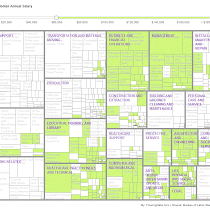2013Sep16
History of Financial Crisis, 2007 - 2010
A recent Pew Research Center report in FacTank, on the history of the financial crisis from 2007 to 2010, analyst, Drew DeSilver says that the chart above is packed with the history of the financial crisis and is taken from a Department of the Treasury power point presentation that summarizes the financial crisis. The full report is also available. The data are taken from Standard and Poor's (S&P) 500 Index which is tracked and reported by the Bureau of Labor Statistics and the Bureau of of Economic Analysis and the Consumer Sentiment Index which is taken from the Survey of Consumers, published monthly by the University of Michigan and Thomson Reuters.
The chart shows the time of the recession, December 2007 through June, 2009 in grey with the activity of the Standard and Poor's (S&P) 500 Index is shown as a line in blue with the scale on the left side of the chart and the Consumer Sentiment Index is shown as a line in orange with the scale on the right side of the chart. Important events are placed on the blue line as black dots on their dates, which are displayed at the bottom of the chart.
TeachingWithData.org has several resources to help faculty engage students in the economics of today's world. They are "You Fix the Budget" from the New York Times and "Make Your Own Deficit-Reduction Plan" from The Wall Street Journal. Both are freely available.
Read more:
http://www.pewresearch.org/
http://www.pewresearch.org/fact-tank/
http://www.pewresearch.org/author/ddesilver/http://www.pewresearch.org/fact-tank/2013/09/13/chart-of-the-week-a-stroll-down-financial-crisis-memory-lane/#comments
http://www.people-press.org/2013/09/12/five-years-after-market-crash-u-s-economy-seen-as-no-more-secure/
http://www.washingtonpost.com/blogs/wonkblog/wp/2013/09/11/five-years-after-the-crisis-these-13-charts-show-whats-fixed-and-what-isnt/?wpisrc=nl_wnkpm
http://www.treasury.gov/connect/blog/Documents/FinancialCrisis5Yr_vFINAL.pdf
http://fcic.law.stanford.edu/report
http://fcic-static.law.stanford.edu/cdn_media/fcic-reports/fcic_final_report_full.pdf
http://www.nber.org/cycles/cyclesmain.html
TeachingWithData.org resources:
http://teachingwithdata.org/resource/3355
http://teachingwithdata.org/resource/3903
Sue Hodge
Related Posts:
About TeachingwithData.org
TeachingWithData.org is a partnership between the Inter-university Consortium for Political and Social Research (ICPSR) and the Social Science Data Analysis Network (SSDAN), both at the University of Michigan. The project is funded by NSF Award 0840642, George Alter (ICPSR), PI and William Frey (SSDAN), co-PI.
Translate
Search This Blog
Popular Posts
-
A study recently featured in the Journal of Comparative Economics examines income inequality in urban China. Capital income increased d...
-
A recent post on the Economist’s Graphic Detail blog includes a global map of cigarette smokers in 2010, as reported by the American Cance...
-
The month of March signaled the beginning of National Women’s History Month, as well as the annual Oscar Awards ceremony, which was held on...
-
According to the Washington Post, since 2009, the unemployment rate in the United States has dropped by 50% . The traditional...
-
If you’ve hit the point in the semester where your classes have fallen into routines and you’d like to spice things up a bit, this webinar i...









Nice information thanks for posting this..
ReplyDeleteSteven Conville
BREAKING NEWS: USD Currency Collapse
ReplyDeleteChina Causes The USD To Fall?
USD Dollar Drops 50% In Value Overnight?
Hey there
I don’t know you have heard this yet…
But the USD Dollar is on the verge of collapse.
In fact since 1973 it’s been on a downward trend…
Dollar-Index-Past-Forty-Years
USD national debt is at an all time high and now financial experts are saying that China is starting to sell their debt holdings to the secondary market.
This means it won’t be too long until the USD crumbles in value!
>>Watch This Video To Learn More<<
I don’t want to be the bringer of bad news, but this is seriously not good for the US since we already have domestic problems of our own, such as immigration and unemployment.
Our economy can not withstand another hit.
This time the USD might actually collapse.
>>Watch This Video To Learn More<<
Make sure you watch it before it’s taken offline.
Speak soon.
[Mr Mark Fidelman]